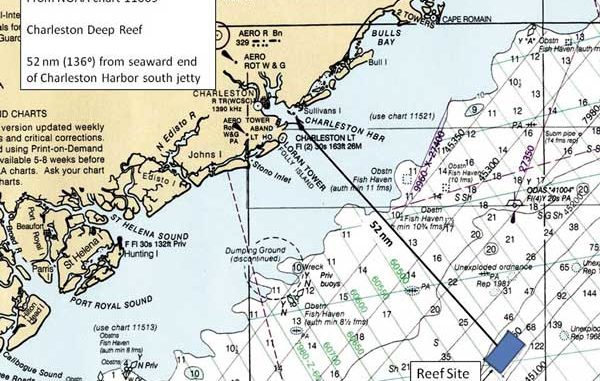
When Capt. Tony Smoak of James Island passed away last year, the sportfishing community responded with an idea for an artificial reef in his memory.
Steve Leasure, captain of the Summer Girl, said that a conversation in the back of his charterboat shortly after Smoak’s death snowballed into a serious effort to build what may be the deepest artificial reef on the east coast — a memorial to their fallen fishing buddy, and a place where people can spread the ashes of their loved ones.
The S.C. Department of Natural Resources already had a permit in place for a new reef, but an agreement with the U.S. Army Corps of Engineers to get parts of the old Cooper River Bridge fell through at the last minute in 2005 when the bridge’s steel hulk was sold for scrap metal and exported to Asia. That left the reef without any materials.
Leasure and other captains set a goal of raising $20,000 to obtain reef-building materials. Due to state budget cuts, private funds will be required for the reef to be built.
The permitted reef site covers 24 square miles and ranges in depth from 328 to 482 feet. It has been dubbed the “Charleston Deep Reef” — and if it is ever built, it would be the deepest artificial reef on the east coast.
What Charleston anglers need now is a rather large vessel that can be taken to the reef site and sunk in order to start some live bottom habitat.
“We are holding out looking for something BIG, like an ex-Navy vessel,” said Leasure, who has already come up with $35,000 for the project. “And (we) are in the first year of fundraising to purchase whatever comes available.”
Due to the current state budget crisis, it is unlikely that the funds to purchase a vessel will be provided, so a series of fundraisers is under way. The first was the inaugural South Carolina Memorial Billfish Challenge, a catch-and-release tournament fished out of Charleston on Sept. 26. The $20,000 goal was met and surpassed when local businesses chipped in to support the angling community, raising $25,000.
On Dec. 7, a skeet shoot was held at Partridge Creek Gun Club in St. George, with 100 sportsmen participating. That raised another $10,000. A third fundraiser will be the Megadock Billfish Tournament this July, in partnership with the Harry Hampton Fund. Please call Leasure at 843-209-2818 if you want to make a donation.
The reef is to be classified as a Type II Marine Protected Area where bottom fishing will not be allowed. As the bottom habitat is built and becomes populated, the food chain will expand vertically, which will benefit trolling for pelagic species.
The reef will be located 52 nautical miles ESE of Charleston, just inside the “226 Hole” — an already popular offshore fishing spot.
Amy Dukes of the SCDNR’s marine resources division said the site was selected with the help of the South Atlantic Fisheries Management Council “for its lack of livebottom, so when new habitat is created, it will be a win-win situation for marine species and sport fishermen.”
A new artificial reef that anglers can’t fish? MPAs are not without some controversy, but in layman’s terms, if you take an unproductive, sandy-bottom area and “make habitat” there, you aren’t taking away anything that anglers were using before.
Thinking in terms of the ecosystem, creating and adding habitat, then leaving it unpressured, will only increase the productivity of the entire area, especially for the fisherman trolling just above it. SCDNR video from its “secret reef” off Georgia clearly shows that an unfished artificial reef is a hub of marine activity.
The Charleston Deep Reef MPA can be a tool to combat what the South Atlantic Fishery Management Council (SAFMC) has declared to be overfishing for some bottom species. Both grouper and snapper stocks were identified as overfished during the June 2007 stock assessment, and recreational fishing for gag grouper, black grouper and red grouper will be suspended in March and April to protect spawning fish. The SAFMC, headquartered in Charleston, is responsible for the management of fish stocks within the federal 200-mile limit off the coasts of North Carolina, South Carolina, Georgia, and Florida to Key West.
Angler access to fishing grounds will always be related to angler advocacy. The American Sportfishing Association reports that the total number of fishermen declined 15 percent between 1996 and 2006. Fewer anglers may not be a bad thing, if the core group that remains stands tall for conservation and shuns the “gimme more” attitudes that may have led to overfishing. Funding and constructing the Charleston Deep Reef project is a great way for saltwater anglers to demonstrate to the non-fishing public that we cherish our marine resources.



Be the first to comment